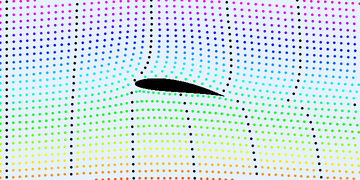-
Asked by staceanator to Carol, Ellie, John, Philip, Rebecca on 28 Jun 2012.
-
Philip Glasson answered on 28 Jun 2012:
Nice Question.. Thank you for asking it
Airplanes fly by continually moving forwards.
.
This makes wind flow both over & under the wings at the same time.
Airplanes wings have a special shape that’s curved on the top and more flat on the bottom.
This shape stretches out the air on top of the wing meaning it has a lower pressure. lower pressure in a vacuum cleaner sucks up dust & dirt . Lower pressure on the wing sucks the wing upwards, keeping the plane in the air.Look at the closely packed dots under the wing and the spaced-out dots above the wing

We call the upward force on the wing. Lift !! =)
-
-
John Welford answered on 28 Jun 2012:
It’s amazing to think how heavy aeroplanes are and that they fly!
There are lots of different forces at work, but they can be simplified to a few basic ones:
Thrust – pushing it forwards
Drag – acting against the thrust (so pulling it backwards)
Gravity – pulling it downwards
Lift – pushing it upwardsHow those forces balance out will determine how it flies. If thrust is greater than drag then it will accelerate forwards, if lift is greater than gravity then it will go upwards.
It also depends what direction the plane is pointing. For example if its pointing straight upwards then Thrust must cancel out both Gravity and Drag. Very few aircraft can actually do this – only a few fighter planes. Usually planes fly roughly parallel to the ground.
Thrust is created by the engines, usually forwards (again there are a few fighter planes that can direct their thrust in other directions to perform very quick manoeuvres).
Lift is really tricky, as there are a few different ways to explain it. One of the ways that seems sensible to me is “deflection”. As air molecules hit the bottom of the wing they are forced to bounce off downwards. This creates an equal force on the bottom of the wing pushing it upwards.
Other ways to think of it are through pressure (how Phil described it), but I prefer deflection as it seems to make more sense to me.
A really important part of thinking about wings is their “angle-of-attack”, which is basically the angle they make with the direction they are travelling. The steeper the angle, the more air molecules the wing is hitting and the larger the Lift force.
This also explains how some aeroplanes can fly upside-down, if the pilot makes sure that the angle-of-attack of the wing still hits air molecules downwards then they will still generate Lift upwards.
It can also be used to explain how an aeroplane can “stall” if it tries to climb too steeply. If the angle-of-attack is too large then air molecules end up bouncing off forwards rather than downwards, creating Drag rather than Lift. You don’t want to be in an aircraft if this happens!
-
Carol White answered on 2 Jul 2012:
Woah I don’t think I can add to either Phil or John’s answers! I learned quite a lot there too! Either way… I sitll don’t like flying!

Comments